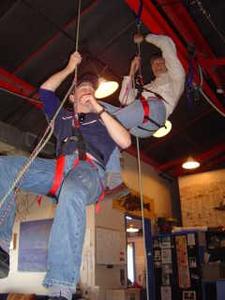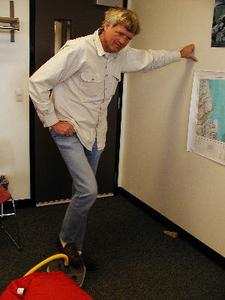
|
|
1 December, 2003
A tall man for a tall job.
Dr. Philip Currie is a rather tall Teutonic looking man with blue gray eyes and a ready smile. He is an engaging man whose passions include good music, good wines and good books. A major drawback for Currie here in Antarctica, has been he has not been able to get out for his daily swim.
When you are an earth science teacher you do not get to specialize in all the areas of earth science, so I must confess I did not know much about Dr. Currie until I looked him up online. This guy is the real deal with respect to dinosaurs! I could spend a couple of pages listing his accomplishments, but you can do that for yourself, what I want to convey to you is Dr. Currie, Antarctic Dinosaur Explorer.
I have learned that his work on dinosaurs focuses on problems with growth and variation, the anatomy and relationships of carnivorous dinosaurs, and the origin of birds. One of his long-term goals is to develop an understanding of the rich Cretaceous ecosystem of Dinosaur Park, and the contemporaneous faunas and habitats of other sites in western North America and Asia.
Although he has traveled to the far reaches of the world, much of it with his wife Eva Koppelhus, also a paleontologist and co-author of several of their books, this is Dr. Currie's first trip to Antarctica. When I asked Dr. Currie what is his greatest hope for this expedition he replied without hesitation, "I would like nothing better than to find a new theropod on this trip." He listed one of his favorite finds to date as the late cretaceous theropod named Ingenia that he and some Mongolian Paleontologists found in Mongolia. Conditions in the Gobi Desert can be pretty primitive but then again some sites in the "civilized" world can be pretty rough too. "We have been trapped in Alberta, Canada, by sudden snow storms, so you see you do not have to travel far to get into pretty rough conditions.
So what drives this quiet man? We'll it is not publicity or the desire for notoriety if my observations count for anything. I would have scarcely have known how famous Dr. Currie is, even after working with him this past week. You see, he is not a boastful man, he lets his work speak for itself, and it's the work, the travel and most important, sharing what he has found with others that he loves. That last one can get you into trouble as he found out when he got in the middle of a communication snafu. A few years back some paleontologists he had worked with, announced that they had found what they thought could be a feathered dinosaur they called Archaeoraptor. This find was actually two different fossils that were found together giving an outward appearance of a single organism. Although it was made clear along every step of the way; that the forward section and tail section could have come from different species, the press jumped on the news and soon the find was distorted into the much sought after missing link between dinosaurs and birds. Well it turns out that they indeed were two different organisms and much ink was devoted to retractions in various publications and there were many red faces.
But Dr. Currie's larger goal is bringing science to all people and getting young folks involved in the process of science. "I realize paleontology is but a small part of science, and that dinosaurs are a very small part of paleontology, however they are an exciting part and can capture young peoples minds and get them excited about the possibilities." He went on to say, "When I was growing up near Toronto, I discovered a dinosaur (albeit a plastic one) in a cereal box when I was six. From then on I was hooked. But it was easy for me to keep my interest going, because when I needed another dinosaur fix, I could visit the museum in Toronto, and get it." He continued, "But for most places in the world, these opportunities did not exist; there was little known about dinosaurs back then, and even less written. Outside of a few major collections in large museums, most places were devoid of fossils." This was the driving reason that Dr, Currie became the pivotal person in the redesign and renovation of the Provincial Museum of Alberta's Dinosaur Gallery. This led to the Royal Tyrrell Museum of Paleontology, Drumheller, Alberta, which boasts one of the world's best dinosaur collections, much of it collected in the fossil beds of Dinosaur Provincial Park, Alberta, Canada, as well as from Dr. Currie's extensive digs he has conducted around the world. "I was at the right place at the right time, and was able to create a place where both amateur and professional paleontologists could work and study."
When I asked Dr. Currie if there was one place he wished he could have done more, he replied, "The Peace River Canyon was going to be flooded for a hydro project. We worked there and exposed more than 1800 fossil footprints before we had to leave. We only got to work two of the eight miles we wanted to survey so there is no telling what fossil finds could remain submerged beneath the water."
He noted that in other cases, it is good to leave some fossil beds unfinished so others can examine and excavate the beds too. This helps to verify ones own work and spreads the research around to fresh eyes.
Dr. Currie has worked in the U.S., Canada, China, Mongolia, and Argentina just to name a few. From Antarctica, he will return home for a couple of months and then will head out on the road again excavating bone beds in far off places. When you talk with Dr. Currie, his excitement towards his work is palpable. When I asked him what was the most important piece of information I could convey to the journals' readers he replied, "Like you, I want people, especially young people, to catch hold of the excitement that science has to offer, we get to go to exotic lands and set foot in places where few others have done so before. Making discoveries of any kind is a rewarding career." To me it is obvious that Dr. Currie has chosen a path in life that he is well suited for and one that makes you anxious to get up in the morning to see what the day will bring.
Tomorrow, Dr. William Hammer, license plate: FROZEN DINO!

Dr. Philip Currie

Dr. Currie practices his rope work above graduate student Nate Smith. (To soften the possible fall)

Dr. Currie "ups the pressure" on an unsuspecting technician.
Contact the TEA in the field at
.
If you cannot connect through your browser, copy the
TEA's e-mail address in the "To:" line of
your favorite e-mail package.
|
